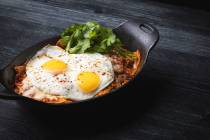Las Vegas cuisine is melting pot of world’s best

Maine has its lobsters, Boston its clam bakes, Buffalo its wings and weck, Chicago its pizza and hot dogs, Seattle its coffee, St. Louis its ribs, Milwaukee its beer and brats, Elko its Basque food and … well, you get the idea.
But what does Las Vegas have? Aside from our de rigueur shrimp cocktails and prime rib, how does one define Las Vegas cuisine?
That, local chefs say, is a challenge in itself.
“I don’t think you can decide what is the Las Vegas cuisine,” said Julian Serrano, executive chef of Picasso at Bellagio and an eponymous tapas restaurant in Aria at CityCenter. “Here in Las Vegas, we have a combination of everything.”
Part of the reason, Serrano said, is that historically, we haven’t produced any foods here. If we had feedlots we might be known for our beef, or if we were near the ocean we might be known for our seafood, but most of us have yet to meet anyone who’s eaten a Joshua tree.
And then there’s the fact that the Las Vegas community is two communities – the tourism corridor and the residential areas. And that things have certainly changed over the years.
Bob Ansara, owner of Ricardo’s Mexican Restaurant, came to Las Vegas in 1978.
“When I first got here, the nonresort corridor was a pretty interesting mix of Americana and the bar-foods scene that I had never seen before, coming from California,” Ansara said.
“When we got here in 1980,” said John Arena, co-owner of Metro Pizza, “a lot of the local restaurants were basically informed by East Coast sensibilities from people who had moved here in the early days of the town’s development from New York and Chicago – chicken-wing places and pizzerias and things that were kind of influenced by that.”
And there was spillover from the tourism corridor. Chefs who had come to work in gourmet rooms in the 1960s were, by the ’70s and ’80s, opening their own restaurants, Arena said.
In the areas frequented primarily by tourists, things were different.
“If you went to Des Moines in 1979,” Ansara said, Las Vegas food would have been defined as “shrimp cocktails, Continental cuisine (Arena calls it “pseudo-Continental”) and cheap breakfasts. Every 10 years or so, the buffets got more audacious and the Continental got more segmented.
“Then, in the late ’80s and ’90s, Wolfgang Puck and Emeril Lagasse came to town. In Des Moines today, they’d tell you about high-end and, I think, buffet. I don’t know that there’s a designated Las Vegas food, except that we’ve gotten cosmopolitan in our own one-horse, Wild West kind of way. Abundance and the extravagance of ingredients still define who we are.”
“Definitely, excess,” agreed Carlos Guia, executive chef of The Country Club at Wynn Las Vegas. “Basically, that we’re always trying to do something over the top that’s going to try to make us stand out. There’s a lot of competition, but it’s good competition. Everybody kind of pushes themself to keep up with the next guy, do the next thing.”
“In a broad stroke, I would say that Las Vegas is a hot spot for all great restaurants from around the United States and internationally, which is very hard to find, other than in New York City,” said David Robins, managing partner, operations, and corporate chef of the Wolfgang Puck Fine Dining Group in Las Vegas
Since he came to Las Vegas in late 1992, Robins said, he’s seen “a proliferation of incredibly talented chefs coming to town but also a proliferation of variety. When I came here, I think Piero’s and The Tillerman and Palace Court were the best places in town. I would tell you now that we have 40 to 45 incredible restaurants in town.”
Hubert Keller, executive chef of Fleur de Lys at Mandalay Bay, remembered feeling the city’s culinary engine getting ready to turn the corner. More than 10 years ago, he said, he would periodically come to Las Vegas with a group of chef friends, gathering at Andre Rochat’s downtown restaurant or at Jean-Louis Palladin’s place at the Rio. He clearly recalled one evening at the latter.
“The event that they put together at that time was probably one of the most fabulous events I ever participated in,” Keller said. “The theme was, you basically cook whatever you want, no limit. Almost kind of a food orgy. The whole night was like that.
“At that time it was totally unbelievable. That imprinted something in me: Something is happening in Las Vegas. I felt like here’s a place where there is no limit, no restrictions, anything goes. I was very impressed by such a thing.”
By the time he was asked to open Fleur de Lys at Mandalay Bay about nine years ago, Keller said, “the movement had already started, big-time.”
He said the feeling he had coming to Las Vegas at that time was similar to his arrival in San Francisco from Brazil in 1982.
“I had that same feel, that I was in the right place here,” he said. “In ’82 nothing had happened in California, but you could feel that underground going.”
“I think today,” Keller said, “I would define it as being a real restaurant city.”
“We have become sort of the best of the best in the world in terms of great representations of the finest cuisines,” said Tom Kaplan, senior managing partner of the Wolfgang Puck Fine Dining Group in Las Vegas. “A lot of the critics from around the United States thought we were a flash in the pan. Everything people were doing, starting in those early years, has proved not to be trendy or a flash in the pan, but really significant cuisine to the point where I’m most proud of it. Las Vegas now, in the fine-dining realm, is almost on a par with London and New York, more than Chicago and more than L.A.”
At the same time, Kaplan said, we’ve maintained the finest tradition of the classic American steak restaurant. While many people, he said, think of the great old steakhouses of New York, “the best examples of a steak restaurant would be here. I think we’re doing it better than New York.”
Kaplan said he thinks that where we’ve fallen short is in the realm of ethnic restaurants. With the exception of Asian cuisines, which have blossomed exponentially since a time when, as Ansara said, “you couldn’t get anything but Chinese food in this town,” that growth hasn’t been seen among other ethnic groups.
But Arena said he sees hope in all of the experimenting that’s being done, especially by younger chefs.
“Now I think you’re seeing a lot of influence – fusion of all the different ethnic groups whose cuisines have come to the forefront,” he said. “There’s a whole new set of rules. What you’re seeing now is a real fusion of cultures and regions – because Las Vegas is such a melting pot – coming together into something that is completely new. We’re going to start to see stuff that you would say can only happen in Las Vegas.
“What we’re seeing now is kind of a really exciting time for what will develop into a unique Las Vegas fusion cuisine.”
Contact reporter Heidi Knapp Rinella at hrinella@reviewjournal.com or 702-383-0474.


















